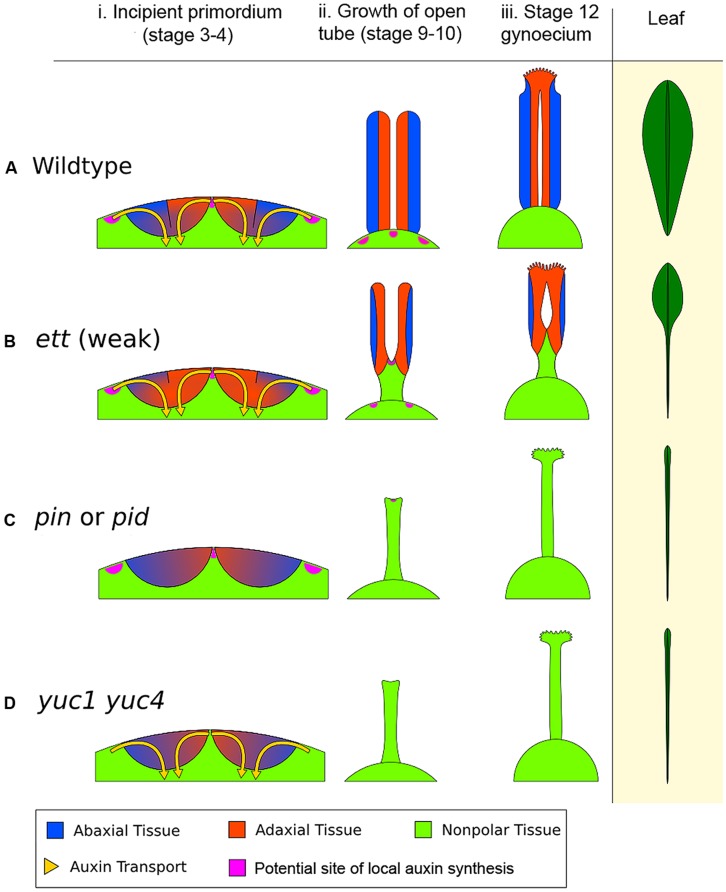FIGURE 6.
The early action model of gynoecium patterning. (A) Wild type (WT) gynoecium development. The diagram in (i) depicts a young floral meristem giving rise to the two incipient carpel primordia, viewed as an enlarged longitudinal section of the floral meristem apex. In WT, opposing auxin flows (indicated by the yellow arrows) converge on the epidermal center of each carpel primordium. The convergence site likely marks the AD/AB boundary, shown as a black line between blue (AB) and orange (AD) domains. The sharp AD/AB boundary ensures upward growth of carpel tube, forming a long tube with AD domain facing interior (ii). Later the cylindrical tube differentiates into stigma/style at the apex and barely visible gynophore at the base (iii). The phenotypic analogy to a normal Arabidopsis leaf with lamina along its entire length is shown on the right. (B) In a weak ett mutant (ett-2), abaxial identity is compromised (but not eliminated entirely), resulting in partial adaxialization of the carpel primordia indicated by expansion of orange color (AD) area (i). As a result, there is diminishing AD/AB boundary, indicated by a shorter boundary line (i). Consequently, only a small area of the carpel primordium near the primordial apex has a clear AD/AB boundary. This shorter (or fuzzier) AD/AB boundary results in limited upward growth and hence a shorter (shallower) tube (ii), and subsequently a reduced ovary valve (iii). This phenotypically resembles leaf polarity mutants (such as double mutants of KAN) with a diminished lamina pushed to the leaf tip. (C) In auxin polar transport mutants such as in pin or pid mutants, the two counter-oriented auxin flows are compromised, resulting in failure to form a sharp AD/AB boundary as well as a lack of clear AD or AB identity, which is indicated by mixed blue-orange color in the primordia (i). Since the AD/AB boundary is required for valve formation, a lack of the AD/AB boundary resulted in only radialized gynophore (ii and iii), which exhibits no AD/AB polarity. (D) In auxin biosynthesis mutants such as in the yuc1 yuc4 double mutants, a lack of local auxin biosynthesis, and hence a reduced auxin flow, results in little or no AD and AB identity being formed and no AD/AB boundary being established, as indicated by the mixed blue-orange color (i). Without the AD and AB polarity boundary, there is little to no carpel valve growth (ii, iii), analogous to a leaf without lamina (Waites and Hudson, 1995), shown on the right diagram. The pink patches highlight putative local auxin synthesis sites based on Cheng et al. (2006). The medial region expression of TAA1 in gynoecium at floral stages 5–9 (Stepanova et al., 2008) is not shown.

